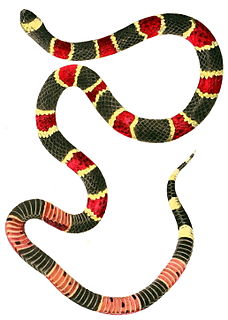
Micrurus is a genus of venomous coral snakes of the family Elapidae.

Geodia is a genus of sea sponge belonging to the family Geodiidae. It is the type genus of its taxonomic family.

Palaemon is a genus of caridean shrimp of the family Palaemonidae. The conventional circumscription of the genus Palaemon is probably paraphyletic. Molecular data suggest that Palaemonetes, as well as the genera Exopalaemon and Couteriella, are nested within Palaemon. Phylogenetic affinities in these groups correspond better with geographical origin than conventional genus assignments.

Cercopidae are the largest family of Cercopoidea, a xylem-feeding insect group, commonly called froghoppers or spittlebugs. They belong to the hemipteran suborder Auchenorrhyncha.

Oroperipatus is a genus of Neotropical velvet worms in the family Peripatidae.
Tubiluchidae is one of the two families of priapulimorphidan priapulid worms.
Antygomonas is a genus of cyclorhagids. It is the only genus in the family Antygomonidae Adrianov & Malakhov, 1994. Species of Antygomonas are commonly referred to as "mud dragons."

Gordius is a genus of worms in the phylum Nematomorpha, the horsehair worms. It was formerly treated as the only genus in the family Gordiidae, but the genus Acutogordius is now considered as distinct. The genus is distributed worldwide except for Antarctica, where no Nematomorpha have been recorded.
Archotuba is a genus of elongated conical tubes that were seemingly deposited by colonial organisms. Known from the Chengjiang, its biological affinity is uncertain; it somewhat resembles the tubes of the 'priapulid' Selkirkia, but a cnidarian affinity is also possible. In the absence of soft parts, there really isn't enough data to confirm a biological affiliation.
Nectonema is a genus of marine horsehair worms first described by Addison E. Verrill in 1879. It is the only genus in the family Nectonematidae described by Henry B. Ward in 1892, in the order Nectonematoidea, and in the class Nectonematoida. The genus contains five species; all species have a parasitic larval stage inhabiting crustacean hosts and a free-living adult stage that swims in open water.

Gordioidea is an order of parasitic horsehair worms. Its taxonomy remains uncertain, but appears to be contained in the monotypic class Gordioida and contains about 320 known species.

Chordodidae is a family of parasitic horsehair worms belonging to the order Gordioidea; its taxonomy is under review.
Parachordodes is a genus of worms belonging to the family Chordodidae.
Paragordionus is a genus of worms belonging to the family Chordodidae.

Paragordius is a genus of worms belonging to the family Chordodidae. It was independently described by both Lorenzo Camerano in 1897 and Thomas Harrison Montgomery Jr. in 1898, though both authors gave the genus the same name.

Phakellia is a genus of sponges belonging to the family Bubaridae. The genus has a cosmopolitan distribution.

Acutogordius is a genus of worms belonging to the family Gordiidae.
Beatogordius is a genus of worms belonging to the family Chordodidae.
Oregodasys is a genus of worms belonging to the family Thaumastodermatidae.
Diplodasys is a genus of worms belonging to the family Thaumastodermatidae.









